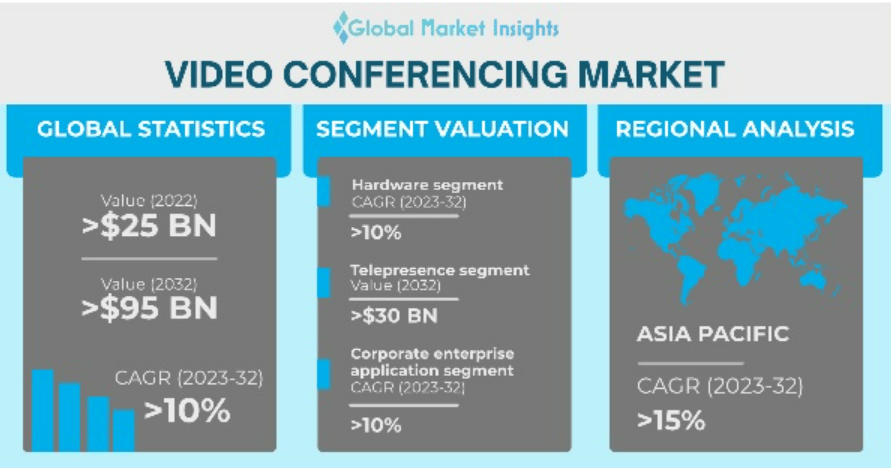The Guide to Video Conferencing: Benefits, Uses, and Future Trends
The days of pixelated faces and choppy audio on video calls are long gone with the emergence of video conferencing for seamless communication and collaboration across distances.
$95 billion by 2032
It is evident from the exponential growth that the video conferencing market will reach $95 billion by 2032, fueling remote work and global connections.
Video conferencing saves time and resources and enhances productivity and communication quality.
Let’s explore video conferencing technology and its applications and advantages, providing a comprehensive understanding of this transformative technology.
Table of Contents
- What is video conferencing?
- How does video conferencing work?
- Main components of video conferencing
- Types of video conferencing
- Benefits of video conferencing
- Uses and applications
- Future trends in video conferencing
- Enhance your virtual meetings with Digital Samba video conferencing API and SDK
What is video conferencing?
Video conferencing is a real-time communication method that enables individuals or groups to connect and interact via audio and video transmission over the Internet.
Unlike traditional phone calls, digital video conferencing offers a more immersive experience. Think of it as a virtual meeting room where you can:
- See and be seen: Facial expressions and body language add depth and nuance to conversations, mimicking the richness of in-person interactions.
- Collaborate seamlessly: Share documents, presentations, and whiteboards in real-time, fostering brainstorming and joint problem-solving.
- Connect globally: Break down geographical barriers and bridge distances, making international teams and cross-cultural collaboration a breeze.
Video conferencing adds a crucial layer of nonverbal communication, allowing for richer context, enhanced collaboration, and stronger relationships. Whether you're catching up with friends around the world, hosting a business meeting with colleagues from different countries and offshore teams, or attending a virtual lecture, video conferencing is the tool that bridges the gap, making communication more seamless.

How to Integrate Video Conferencing into Your Website
Read the blog
How does video conferencing work?
Video conferencing involves a two-step process: compressing and transferring. Imagine your camera and microphone as sensors, capturing sights and sounds as waves. Codecs then crunch these waves into tiny digital packets.
These packets travel over the internet, often to a cloud server, which acts like a mailroom, sorting and sending them to everyone on the call. Finally, the data is decompressed back at each participant's device into visuals and sounds, recreating the original conversation.
But what makes video conferencing better than traditional audio-only calls?
Enhanced engagement
Visual aids
Remote Participation
Main components of video conferencing
Video conferencing requires several key hardware and software components to ensure effective communication and collaboration.
Firstly, let's talk about hardware. While sophisticated setups exist, you can get started with the basics:
- Device: A smartphone, tablet, or computer with a camera and microphone.
- Display: A screen to see other participants (e.g., a laptop monitor or a TV).
- Internet connection: Stable and sufficient bandwidth for smooth video and audio transmission.
Next, choose your software platform. Many options, such as Digital Samba Embedded, are available, catering to different needs and budgets. Video conferencing platforms offer features like screen sharing, recording, and virtual backgrounds, so pick one that aligns with your needs.
Types of video conferencing
From basic one-on-one calls to large-scale virtual events, video conferencing platforms offer a spectrum of options tailored to different contexts and requirements.
The main types of video conferencing are:
Point-to-point video calls
This simplest form involves a direct video connection between two individuals or endpoints. It's ideal for one-on-one communication, such as interviews, video banking, or quick discussions.
Multipoint video conference
It involves three or more participants joining into a single video call simultaneously. Participants can see and interact with each other in real-time, making it suitable for interactive discussions, team meetings, online classes, and brainstorming sessions.
Room-based video conferencing
It utilises dedicated conference rooms equipped with specialised hardware, such as high-definition cameras, large displays, and advanced audio systems. This facilitates seamless communication for executive meetings and larger groups in a professional setting.
Desktop video conferencing
Desktop video conferencing software lets users participate in video calls directly from their computers or laptops. These solutions are versatile and accessible by everyone, allowing individuals to seamlessly hop into meetings from any location through the Internet.
Telepresence video conferencing
It offers high-definition visuals and spatial audio, creating a feeling of being in the same physical space with participants. Telepresence is ideal for large-scale meetings, international collaborations, or high-impact negotiations where presence is crucial.
Benefits of video conferencing
Video conferencing in business isn't just a cool tech tool but is a game-changer with many benefits that redefine how we connect and work in the modern world.
Let's see how embracing video conferencing can unlock new possibilities:
Flexibility and accessibility
Cost savings
Time efficiency
Boosted productivity and collaboration
Reduction in carbon footprint

Video Conferencing Advantages and Disadvantages
Read the blog
Uses of video conferencing and applications
The applications and uses of video conferencing extend far beyond just business meetings. Let's explore how this versatile tool is transforming various industries:
1. Sales and marketing
Sales teams utilise video conferencing to conduct product demonstrations, video presentation, and client meetings remotely, enabling them to reach a broader audience. Additionally, marketers leverage video conferencing for webinars, virtual events, and promotional activities to showcase products and services.
For example, HubSpot, a global marketing software company, leverages video conferencing extensively for sales demos, lead nurturing, and customer support.
2. HR and remote recruitment
Human resources departments leverage video conferencing AI Tools for HR to conduct remote interviews, onboard new hires, and facilitate virtual meetings with offshore and nearshore teams, increasingly integrating AI in staffing to optimise these processes.
A real-world example is GitLab, a leading provider of open-source DevOps software, which embraces remote work and conducts all interviews virtually.
3. Training sessions and e-learning
Video conferencing platforms are utilised for hosting virtual training sessions, workshops, and educational seminars. This allows organisations to deliver interactive learning experiences to employees, students, or participants located remotely for continuous skill development and knowledge sharing.
Coursera, an online course platform, utilises video conferencing to connect instructors with students globally. This allows them to offer interactive live sessions and enhance the learning experience.
4. Telehealth
In the healthcare sector, video conferencing enables remote consultations, diagnostic assessments, and patient monitoring, expanding access to medical services and improving healthcare delivery.
Telehealth platforms facilitate secure and confidential communication between healthcare providers and patients, offering convenience and flexibility in accessing healthcare services from home or remote locations.
Amwell, a leading telehealth provider, offers virtual consultations for various medical conditions. This allows patients to connect with doctors quickly and conveniently, improving access to healthcare and reducing wait times.
Future trends in video conferencing
As meeting technology continues to evolve, several trends are poised to shape the future of video conferencing. Let’s explore some of them below:
Artificial intelligence integration
5G technology impact
Virtual reality and augmented reality
Enhanced security measures

Top 8 Trends in Video Conferencing for 2024 and Beyond
Read the blog
Enhance your virtual meetings with Digital Samba video conferencing API and SDK
Experience the next-generation communication to revolutionise your virtual meetings with Digital Samba's powerful video conferencing SDK and API with features like:
- Crystal-clear audio and video: Seamlessly connect and collaborate with stunning clarity.
- Unmatched compliance: Stay ahead of regulations with comprehensive features in compliance with GDPR, offering unparalleled security and trust.
- Enhanced security: Ensure your meetings are secure with advanced features like end-to-end and TLS encryption.
- Effortless integration: Integrate seamlessly with your existing workflows and applications.
Don't settle for ordinary meetings. Leverage the potential of Digital Samba's video conferencing to drive productivity and success. Sign up today and revolutionise your virtual interactions.
FAQ
The meaning of video conferencing refers to a method of communication that uses video conferencing technology to connect people remotely. This technology provides a way to hold meetings, discussions, and presentations across different locations as if participants were in the same room.
Video conferencing works by transmitting audio and video data over the internet. Through video conferencing software, users connect to a virtual meeting room, where video and audio streams are shared in real time. This process involves cameras, microphones, speakers, and a stable internet connection to deliver smooth communication.
The uses of video conferencing are vast, including applications in business communication, online learning, telemedicine, and customer service. It allows businesses to conduct virtual meetings, enables remote education for students, and provides healthcare professionals with a way to consult with patients remotely.
A video conferencing example in business communication could be a company’s weekly team meeting conducted over Digital Samba, where team members from different locations join a virtual room to discuss projects and updates. Another example is a telemedicine consultation conducted through a secure video conferencing platform between a doctor and a patient.
The benefits of video conferencing include improved accessibility, cost savings on travel, and enhanced productivity. It allows people to connect instantly from different locations, making it a powerful tool for businesses, educators, and healthcare providers.
The future of video conferencing includes advancements in AI, augmented reality, and improved video conferencing technology for better connectivity and user experience. Emerging trends focus on making virtual interactions more immersive, accessible, and secure.
Share this
You May Also Like
These Related Stories

10 best WordPress Video Chat Plugins
%20-%20Digital%20Samba.webp)
Video Conference as a Service (VCaaS): Definition, Working, and Use Cases
.webp)

